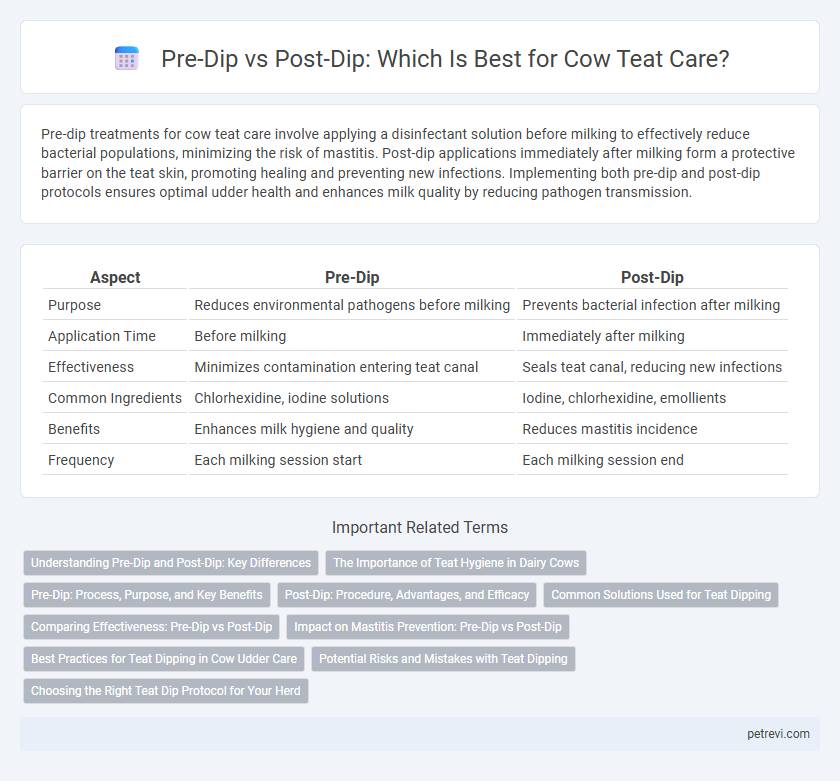Pre-dip treatments for cow teat care involve applying a disinfectant solution before milking to effectively reduce bacterial populations, minimizing the risk of mastitis. Post-dip applications immediately after milking form a protective barrier on the teat skin, promoting healing and preventing new infections. Implementing both pre-dip and post-dip protocols ensures optimal udder health and enhances milk quality by reducing pathogen transmission.
Table of Comparison
| Aspect | Pre-Dip | Post-Dip |
|---|---|---|
| Purpose | Reduces environmental pathogens before milking | Prevents bacterial infection after milking |
| Application Time | Before milking | Immediately after milking |
| Effectiveness | Minimizes contamination entering teat canal | Seals teat canal, reducing new infections |
| Common Ingredients | Chlorhexidine, iodine solutions | Iodine, chlorhexidine, emollients |
| Benefits | Enhances milk hygiene and quality | Reduces mastitis incidence |
| Frequency | Each milking session start | Each milking session end |
Understanding Pre-Dip and Post-Dip: Key Differences
Pre-dip involves applying a disinfectant solution to cow teats before milking to reduce bacterial load and prevent mastitis, while post-dip is applied immediately after milking to protect teat skin and further inhibit bacterial growth. Pre-dipping targets pathogens present on the teat surface, effectively lowering infection risk during milking, whereas post-dipping creates a protective barrier, promoting teat health and enhancing udder hygiene. Both are essential components of an effective mastitis control protocol, optimizing dairy herd health and milk quality.
The Importance of Teat Hygiene in Dairy Cows
Teat hygiene in dairy cows is critical for preventing mastitis and ensuring milk quality, with both pre-dip and post-dip applications playing essential roles. Pre-dip disinfects teats before milking, reducing bacterial load and minimizing infection risk, while post-dip creates a protective barrier to prevent new bacteria from entering the teat canal after milking. Effective use of both pre-dip and post-dip treatments significantly enhances udder health, leading to improved milk yield and quality in dairy herds.
Pre-Dip: Process, Purpose, and Key Benefits
Pre-dip for cow teat care involves applying a disinfectant solution to teats before milking, significantly reducing bacterial load and minimizing mastitis risk. This process ensures that pathogens present on the skin surface are effectively eliminated, preparing teats for hygienic milking. Key benefits include enhanced udder health, improved milk quality, and decreased incidence of clinical and subclinical mastitis.
Post-Dip: Procedure, Advantages, and Efficacy
Post-dip teat care involves applying an antiseptic solution immediately after milking to create a protective barrier against pathogens, reducing the incidence of mastitis in cows. This procedure enhances teat skin condition by promoting healing and preventing new infections, increasing overall udder health and milk quality. Studies show post-dip treatments significantly lower bacterial contamination compared to pre-dip, making it a critical step in effective mastitis prevention protocols on dairy farms.
Common Solutions Used for Teat Dipping
Common solutions used for cow teat dipping include iodine-based dips, chlorhexidine, and lactic acid formulations, which effectively reduce bacterial load on teats to prevent mastitis. Pre-dip solutions are typically designed to thoroughly cleanse and sanitize the teat before milking, while post-dip products focus on forming a protective barrier to inhibit bacterial entry after milking. Both types often incorporate emollients to maintain teat skin health and improve teat condition, optimizing udder hygiene and dairy cow health.
Comparing Effectiveness: Pre-Dip vs Post-Dip
Pre-dip solutions applied before milking significantly reduce bacterial load on cow teats, preventing mastitis by eliminating pathogens prior to teat exposure. Post-dip treatments, used immediately after milking, form a protective barrier that minimizes bacterial entry through the teat canal during the vulnerable post-milking period. Studies demonstrate pre-dip efficacy in lowering initial contamination, while post-dip is crucial for ongoing teat protection, suggesting an integrated approach maximizes udder health.
Impact on Mastitis Prevention: Pre-Dip vs Post-Dip
Pre-dip teat disinfectants reduce bacterial load on teats before milking, significantly lowering the risk of mastitis by preventing pathogen transfer during milking. Post-dip applications create a protective barrier after milking, inhibiting bacterial colonization and further reducing mastitis incidence. Combining both pre-dip and post-dip treatments can maximize udder health and minimize mastitis cases in dairy cows.
Best Practices for Teat Dipping in Cow Udder Care
Pre-dip solutions applied before milking effectively reduce bacterial load on cow teats, minimizing the risk of mastitis by targeting pathogens on the skin surface. Post-dip treatments create a protective barrier that seals the teat canal after milking, preventing new infections during the vulnerable period. Combining pre-dip and post-dip routines with proper teat cleaning and drying ensures optimal udder health and milk quality in dairy herds.
Potential Risks and Mistakes with Teat Dipping
Pre-dip and post-dip teat care are essential for preventing mastitis but improper application can increase infection risk. Potential risks include using contaminated solutions, incomplete coverage, or insufficient contact time, leading to ineffective pathogen control. Mistakes such as skipping pre-dip cleansing or inadequate post-dip barrier formation compromise teat skin health and allow bacterial ingress.
Choosing the Right Teat Dip Protocol for Your Herd
Selecting the right teat dip protocol for your herd involves evaluating the effectiveness of pre-dip and post-dip solutions in preventing mastitis while maintaining teat skin health. Pre-dip teat dips typically contain strong disinfectants to eradicate pathogens before milking, reducing bacterial load on the teats, whereas post-dip products focus on creating a protective barrier to inhibit bacterial entry after milking. Optimizing teat care requires balancing product formulation, milking routines, and environmental factors to minimize infection risks and ensure udder health.
Pre-dip vs Post-dip for Cow teat care Infographic

 petrevi.com
petrevi.com